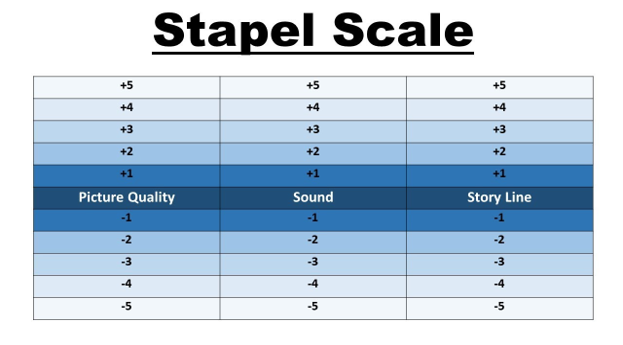
The Stapel scale is not your average survey. It’s like a secret decoder ring that can reveal your true attitudes and beliefs. By using a series of statements, the Stapel scale measures how strongly you agree or disagree with each one.
But here’s the catch: some statements are intentionally designed to be ambiguous or even contradictory!
This clever trickery helps uncover the hidden nuances of your opinions and can provide valuable insights into your thought process.
So if you’re ready to unlock the mysteries of your own mind, keep reading!
What is Stapel Scale?
Named after its developer, Gerard Stapel, the scale typically uses a -2 to 2 or even -10 to 10-point scale, with endpoints labeled strongly disagree and strongly agree.

Let’s take an example for a better understanding, suppose you want to evaluate the top restaurant choices in your neighborhood. You can use the Stapel scale to rank a list of five restaurants from most preferred to least preferred. The person responding would select the restaurant they prefer most with a score of 5, the second best with a score of 4, and so on.
Characteristics of a Stapel Scale
The Stapel scale can be categorized with a single adjective in the middle on a scale that can either be vertical or horizontal. A respondent can express their opinion on the adjective through the numeric values on the scale.
- The positive and negative scores on the scale indicate the opinion or sentiment of the participant about the opinion or statement. A high rating on the scale would reflect that the individual strongly agrees with the opinion. Whereas, a lower rating on the scale would mean the participant disagrees with the statement.
- Numeric values on the scale make it easy for researchers and analysts to perform qualitative analysis of the data. The research results can be easily analyzed and answer the primary hypothesis.
- Researchers can draw out patterns and make assumptions from the information obtained.
ALSO READ: How Can Survey Rating Scales Create Easy & Engaging Surveys?Where Can I Use Stapel Scale Surveys?
Now, let’s take an example of where and when we can use this scale to derive insights and conclusions.
- Companies can use a Stapel scale to gather customer feedback on their respective products and services.
- Evaluate customer satisfaction with a particular business.
- Measure how the marketing campaign has fared with the target audience.
- To track changes in customer needs over time and ensure customer loyalty.
Stapel Scale Research Questions
You can ask Stapel scale questions alone or in a group. They have a set number of answers with no middle option.
How satisfied were you with the customer experience today?
Unsatisfied -5 -4 -3 -2 -1 0 1 2 3 4 5 Satisfied
Here, we have the +5 to -5 matrix. Researchers allow the participants to express their opinions on the customer experience. A high number on the scale is positive feedback, whereas a lower number is negative feedback.

Advantages
The Stapel scale offers the following advantages to its researchers:
1. Cost-effective: Stackable surveys are relatively inexpensive to conduct, and the data collected is highly reliable. It is easy to design survey questions, and the numeric values make the data quantifiable for analysis.
2. Easy to use: Easy to complete and administer by the respondents and researchers. The respondent participating in the survey can easily complete the survey. In order to give their opinion, they need to select the numeric value.
3. Flexible: Can be used to measure a wide variety of items, including opinions, behaviors, and attitudes. Which is why the Stapel scale is used in a variety of fields. As it can give numeric value to the qualitative data, making it easier to draw conclusions.
4. Accurate: The data collected through such surveys is highly reliable and accurate. The easy-to-use survey enables the respondents to give accurate answers. The simple and concise survey format allows the participants to express their opinions without any complications.
5. Quick: Respondents to the survey are just required to select the number on the scale that represents their opinion. In cases where they harbor strong disagreeability or agreeability, they can simply select the respective ends of the scale. This allows them to conclude the survey quickly.
6. Comparable: Such surveys allow the researchers to compare different groups. Since the surveys are evaluated through numeric numbers, researchers can assess the agreeability and disagreeability of the statements among different groups.
7. Customizable: These questionnaires can be customized to fit the needs of the research project. If a company wants to conduct a survey to assess its after-sales service, it can customize its options from unsatisfactory to satisfactory.
ALSO READ: Example Of A Survey Questionnaire: Formatting Guidelines & TemplatesDisadvantages of the Stapel Scale
- There is a certain limitation to what it can measure. For example, it can measure how much you like or dislike something, but it does not give any importance to other factors that might influence your opinion.
- The results are quantifiable but can also be hard to analyze. You can’t always tell how people are feeling or why they picked the answers they did.
- A small number of questions usually limits Stapel scale surveys. This means you are only obtaining very little information from people.
- It offers a limited scope for creativity and can be boring for people to fill out. They are usually just a bunch of questions with no pictures or anything else to make them interesting.
In Conclusion
The Stapel scale survey is an effective research tool that can collect data quickly from a large group of participants.
Numeric values representing the intensity of the opinion with respect to the statement made make it easy to analyze and identify patterns. This method is reliable and easy to administer, making it an ideal choice for researchers and organizations.




